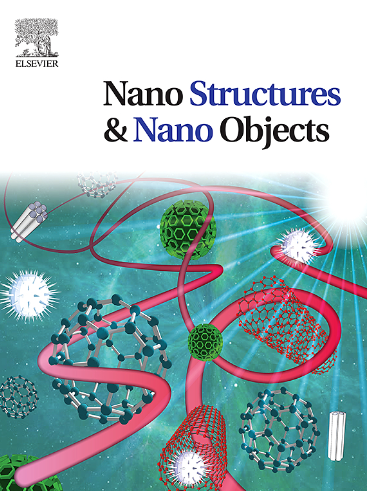Thermal-flow characteristics of an Ellis hybrid nanofluid containing polytetrafluoroethylene-SWCNTs over a stretching/shrinking cylinder with slip effect
IF 5.45
Q1 Physics and Astronomy
引用次数: 0
Abstract
Hybrid nanofluids containing polytetrafluoroethylene (PTFE) nanoparticles and single-walled carbon nanotubes (SWCNTs) in a H2O–carboxymethyl cellulose (CMC) medium, using Ellis fluid model, exhibit excellent thermal conductivity and enhanced viscosity. These enhanced properties make them ideal for applications in thermal management systems, medical technologies, tribology, and sustainable energy solutions, highlighting their potential for improved performance and efficiency. This study focuses on analyzing the characteristics of Ellis hybrid nanofluid flow along a stretching or shrinking cylinder, considering the combined impacts of thermal radiation, slip, magnetic field, and suction/blowing. A mathematical model is developed using partial differential equations, which are converted into dimensionless ODEs via similarity transformations. These expressions are then solved numerically with the aid of the bvp4c solver. Graphical representations are utilized to examine the effects of key factors on the velocity and temperature profiles, as well as on the skin friction coefficient and the local Nusselt number. The results show that the curvature parameter, Ellis fluid parameter, and stretching/shrinking parameter enhance flow, while Forchheimer number, porosity, slip, and suction/blowing parameters reduce it. Also, an upsurge in Eckert number, magnetic and radiation parameters enhance temperature, while higher porosity and velocity slip reduce it. Moreover, an increase in curvature parameter reduces the absolute value of the skin friction coefficient, along with rises in velocity slip and shrinking parameters.
含有聚四氟乙烯- swcnts的Ellis混合纳米流体在具有滑移效应的拉伸/收缩圆柱体上的热流特性
采用Ellis流体模型,在h2o -羧甲基纤维素(CMC)介质中制备含有聚四氟乙烯(PTFE)纳米颗粒和单壁碳纳米管(SWCNTs)的混合纳米流体,表现出优异的导热性和增强的粘度。这些增强的性能使其成为热管理系统、医疗技术、摩擦学和可持续能源解决方案应用的理想选择,突出了其提高性能和效率的潜力。考虑热辐射、滑移、磁场和吸力/吹气的综合影响,重点分析了Ellis混合纳米流体沿拉伸或收缩圆柱体的流动特性。利用偏微分方程建立数学模型,通过相似变换将偏微分方程转化为无量纲偏微分方程。然后借助bvp4c求解器对这些表达式进行数值求解。使用图形表示来检查关键因素对速度和温度分布的影响,以及对表面摩擦系数和局部努塞尔数的影响。结果表明,曲率参数、Ellis流体参数和拉伸/收缩参数对流动有促进作用,而Forchheimer数、孔隙度、滑移和吸吹参数对流动有抑制作用。此外,埃克特数、磁性和辐射参数的增加会提高温度,而孔隙度和速度滑移的增加会降低温度。曲率参数的增大减小了表面摩擦系数的绝对值,同时速度滑移和收缩参数增大。
本文章由计算机程序翻译,如有差异,请以英文原文为准。
求助全文
约1分钟内获得全文
求助全文
来源期刊

Nano-Structures & Nano-Objects
Physics and Astronomy-Condensed Matter Physics
CiteScore
9.20
自引率
0.00%
发文量
60
审稿时长
22 days
期刊介绍:
Nano-Structures & Nano-Objects is a new journal devoted to all aspects of the synthesis and the properties of this new flourishing domain. The journal is devoted to novel architectures at the nano-level with an emphasis on new synthesis and characterization methods. The journal is focused on the objects rather than on their applications. However, the research for new applications of original nano-structures & nano-objects in various fields such as nano-electronics, energy conversion, catalysis, drug delivery and nano-medicine is also welcome. The scope of Nano-Structures & Nano-Objects involves: -Metal and alloy nanoparticles with complex nanostructures such as shape control, core-shell and dumbells -Oxide nanoparticles and nanostructures, with complex oxide/metal, oxide/surface and oxide /organic interfaces -Inorganic semi-conducting nanoparticles (quantum dots) with an emphasis on new phases, structures, shapes and complexity -Nanostructures involving molecular inorganic species such as nanoparticles of coordination compounds, molecular magnets, spin transition nanoparticles etc. or organic nano-objects, in particular for molecular electronics -Nanostructured materials such as nano-MOFs and nano-zeolites -Hetero-junctions between molecules and nano-objects, between different nano-objects & nanostructures or between nano-objects & nanostructures and surfaces -Methods of characterization specific of the nano size or adapted for the nano size such as X-ray and neutron scattering, light scattering, NMR, Raman, Plasmonics, near field microscopies, various TEM and SEM techniques, magnetic studies, etc .
 求助内容:
求助内容: 应助结果提醒方式:
应助结果提醒方式:


